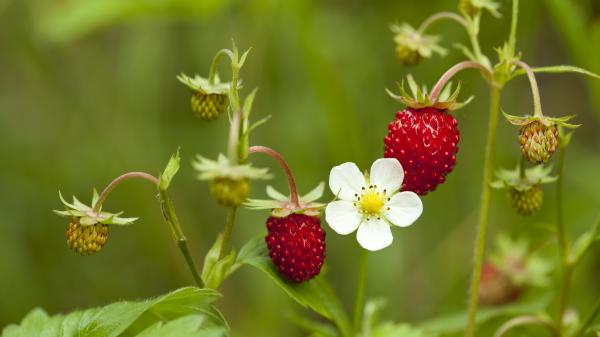The wild strawberries that start to ripen during early summer gave name to the Full Moon in June. Other names are Rose Moon, Hot Moon, and Mead Moon.
In ancient times, it was common to track the changing seasons by following the lunar month rather than the solar year, which the 12 months in our modern calendar are based on.
For millennia, people across Europe, as well as Native American tribes, named the months after features they associated with the Northern Hemisphere seasons, and many of these names are very similar or identical.
Full Moon Names
Today, we use many of these ancient month names as Full Moon names. A common explanation is that Colonial Americans adopted many of the Native American names and incorporated them into the modern calendar.
However, it seems that it is a combination of Native American, Anglo-Saxon, and Germanic month names which gave birth to the names commonly used for the Full Moon today.
Some years have 13 Full Moons, which makes one of them a Blue Moon, as it doesn't quite fit in with the traditional Full Moon naming system. However, this is not the only definition of a Blue Moon.
Wild Strawberries

Alpine strawberry bloom and berry.
©iStockphoto.com/dabjola
June’s Full Moon is named after the wild strawberries that start to ripen during this month. According to some sources, a European name for this early summer month was Rose Moon, and another was Hot Moon, for the beginning of the summer heat. Other sources quote Mead Moon as the Anglo-Saxon name because this was the time for mowing the meads, or meadows.
There are several different kinds of wild strawberries. The native North American type is the Virginia strawberry (Fragaria virginiana), also known as Mountain strawberry or Common strawberry. It grows naturally in the United States, including Alaska, and Canada. It has also been exported; one popular variety, which was imported to Great Britain in the early 1900s, is called Little Scarlet.
It was an accidental cross of Fragaria virginiana and the South American Fragaria chiloensis, also know as Sand or Beach strawberry, with larger fruit, which resulted in the modern strawberry grown commercially and in gardens, the Fragaria ananassa.
Europe has its own native wild strawberry; the Alpine strawberry (Fragaria vesca), also called European strawberry, Woodland strawberry, or fraisier des bois.
New Species in Oregon
In 2012, a new wild strawberry species was discovered in the high peaks of Oregon's Cascade Mountains at elevations of about 3000 to 5000 feet (900 to 1500 meters). The species is endemic to the Western Cascades, and Dr. Kim Hummer who discovered it named the species Fragaria cascadensis. It differs from other strawberry species both in the structure of the leaves and the fruit surface. It also has 10 sets of chromosomes, unlike other wild and commercial strawberries which have 8 sets of chromosomes.
Close to Summer Solstice
Around every 20 years, the Strawberry Moon coincides with the summer solstice, which is either on June 20, 21, or 22.


No comments:
Post a Comment